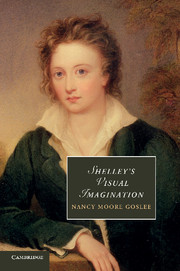Book contents
- Frontmatter
- Contents
- List of illustrations
- Acknowledgments
- 1 Introduction: text and figure
- 2 Mab's metamorphoses
- 3 “Hymn to Intellectual Beauty”: visual texts, invisible figure
- 4 “Clear elemental shapes”: communicating Greek liberty in Laon and Cythna
- 5 Anarchy's textual progress: representing liberty
- 6 Refiguring genre in Shelley's “Ode to Liberty”
- 7 Dispersoning Emily: drafting as plot in Epipsychidion
- 8 “Compelling / All new successions”: death and the poet's figurations in Adonais
- 9 The Triumph of Life: figure, history, and inscription
- Notes
- Bibliography
- Index
- CAMBRIDGE STUDIES IN ROMANTICISM
4 - “Clear elemental shapes”: communicating Greek liberty in Laon and Cythna
Published online by Cambridge University Press: 05 March 2014
- Frontmatter
- Contents
- List of illustrations
- Acknowledgments
- 1 Introduction: text and figure
- 2 Mab's metamorphoses
- 3 “Hymn to Intellectual Beauty”: visual texts, invisible figure
- 4 “Clear elemental shapes”: communicating Greek liberty in Laon and Cythna
- 5 Anarchy's textual progress: representing liberty
- 6 Refiguring genre in Shelley's “Ode to Liberty”
- 7 Dispersoning Emily: drafting as plot in Epipsychidion
- 8 “Compelling / All new successions”: death and the poet's figurations in Adonais
- 9 The Triumph of Life: figure, history, and inscription
- Notes
- Bibliography
- Index
- CAMBRIDGE STUDIES IN ROMANTICISM
Summary
PREFATORY
Laon and Cythna; or, The Revolution of the Golden City: a Vision of the Nineteenth Century is a long narrative showing how poet–prophets might work “to free the world from its dark slavery,” to free it from all coercive political and intellectual power even in the face of reasserted tyranny. In Queen Mab, the ruins of ancient civilizations are haunting memories of tyrannies overthrown and yet resurgent in new territories, with the exception of “the ghost of Liberty” haunting a now-ruined classical Athens. In Laon and Cythna a cultural inheritance of once-active liberty, manifested in the visible ruins of Greece, educates Laon and Cythna as children, and the framing narrator remembers the same inheritance as he attempts to revive cast-down hopes for the failed French Revolution. No single, central visionary energy figured as a named allegorical personification guides the characters or narrators as in “Intellectual Beauty.” Nor are the many personifications that work in the poem voiced from above, abstracted from events, like those of Queen Mab as she critiques mass ideological enchantment and envisions reform. Instead, the most striking aspect of personification in Laon and Cythna is that the characters, more or less realistic historical agents within the visionary narrative frame, themselves develop the personifications – some positive, some negative. They do this with deliberate self-consciousness, well aware of the fictional, yet persuasive rhetorical properties of their figures, both verbal and visual.
- Type
- Chapter
- Information
- Shelley's Visual Imagination , pp. 68 - 94Publisher: Cambridge University PressPrint publication year: 2011

